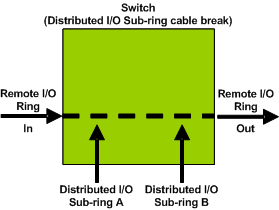|
Remote I/O and Distributed I/O Defined Architecture: Junctions
|
|
|
Original instructions
|

|
Time
|
Remote I/O Ring In
|
Distributed I/O Sub-ring
|
Remote I/O Ring Out
|
Comment
|
|---|---|---|---|---|
|
T0
|
1
|
a (started)
|
|
packet 1 arrived after transmission of packet a begins
|
|
T1
|
2
|
b
|
a
|
packets 2 and b arrive simultaneously
|
|
T2
|
3
|
c
|
1
|
packets 3 and c arrive simultaneously
|
|
T3
|
4
|
d
|
2
|
packets 4 and d arrive simultaneously
|
|
T4
|
5
|
e
|
3
|
packets 5 and e arrive simultaneously
|

|
Time
|
Remote I/O Ring In
|
Distributed I/O Sub-ring A
|
Distributed I/O Sub-ring B
|
Remote I/O Ring Out
|
Comment
|
|---|---|---|---|---|---|
|
T0
|
1 (started)
|
a
|
p
|
|
packets a and p arrive after transmission of packet 1 begins
|
|
T1
|
2
|
b
|
q
|
1
|
packets 2 , b and q arrive simultaneously
|
|
T2
|
3
|
c
|
r
|
2
|
packets 3, c and r arrive simultaneously
|
|
T3
|
4
|
d
|
s
|
3
|
packets 4, d and s arrive simultaneously
|
|
T4
|
5
|
e
|
t
|
4
|
packets 5, e and t arrive simultaneously
|